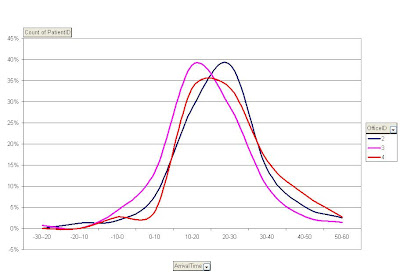Mark just arrived to his appointment 5minutes late for a 5minute appointment. Normally I’d rush in to see him before my next appointment which is ½ hour but he walked by my window opening the lid on a cup of coffee (that he must have obviously just bought) so he can wait. When should he have arrived?
The goal of our clinic is to match my time with the patients’. The more space in the day, the greater the wait time to get an appointment. The tighter the schedule, the greater the risk of a long in-office wait.
Having people arrive prior to the scheduled appointment with the doctor has two purposes. One is to allow them to perform the necessary pre-appointment steps (what lean specialists would call value-added steps) such as registration and review of the medical history. It also allows the doctor to pack the schedule by creating a buffer of time. Office wait times (not associated with necessary steps) are non-value added for the patient and should be minimized.
Since neither the patients nor the doctors timing is perfect some wait is inevitable. Below is a graph of patient arrival time vs scheduled time. If negative, they arrived after the appointment time. If positive, they arrived prior to it. All are asked to arrive 15minutes prior to the appointment.
The goal of our clinic is to match my time with the patients’. The more space in the day, the greater the wait time to get an appointment. The tighter the schedule, the greater the risk of a long in-office wait.
Having people arrive prior to the scheduled appointment with the doctor has two purposes. One is to allow them to perform the necessary pre-appointment steps (what lean specialists would call value-added steps) such as registration and review of the medical history. It also allows the doctor to pack the schedule by creating a buffer of time. Office wait times (not associated with necessary steps) are non-value added for the patient and should be minimized.
Since neither the patients nor the doctors timing is perfect some wait is inevitable. Below is a graph of patient arrival time vs scheduled time. If negative, they arrived after the appointment time. If positive, they arrived prior to it. All are asked to arrive 15minutes prior to the appointment.

I’ve shown before that in our office registration and review of the medical history takes 14 +/- 7 minutes. Based on a normal distribution, roughly 66% of people will require 21minutes or less for the pre-doctor time. The reason patients are not asked to arrive 21 minutes prior to the appointment, is that there is variation in the arrival time which favours the office. Patients tend to exceed our expectations.

Since the average patient arrives 22 +/- 12 minutes before the appointment the 15 minutes is appropriate but the math is not simple. If the patient pool had a more complicated medical history or the administrative staff was unable to manage the crush of patients every 15 minutes then the window would have to be expanded and with it the non-value added time. For other offices, adding the normal arrival variation to the value-added pre-appointment steps will allow you to calculate when to have patients arrive.






No comments:
Post a Comment